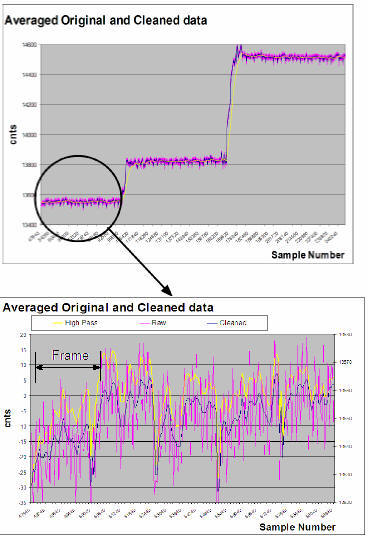
Below is a discussion about a digital signal file from a bench measurement sent by a client that shows:
proficiency in using spread sheets and data bases
knowledge on digital filters
In depth analysis of a problem.
The file was loaded to an MS ACCESS table (ImportTable). Another table was generated from this one where the primary key was an sample Id derived from the field x_value in the original file. The videoOutput field, originally expressed as a floating point value, was transformed into and 16 bit integer field to resemble what the DSP is going to reading from the EPLD. The transformed equation becomes:
DSP input = Int(video_output_mv*4/3000*65535+0.5)

A chart with the transformed original signal in the file “pixel3 40mA controlled cold med hot 10kHz” follows.
In the blow-up of the circled detail two very distinctive interference signals can be observed. A 60 Hz hum and an 833 Hz wave, probably from some switching power supply (guessing here…).
These interferences signals are probably introduced by the temporary measurement setup and are unlikely to be present in the prototype (again making a supposition here…). We applied two digital notch filters (60 Hz and 833) to the data stream and got a fair signal.


The spikes t hat remain in the filtered signal showing every 40 ms are due to gaps in signal sampling (probably the time for downloading data), which cause phase discontinuities in both interference signals. The signal expected to be sampled from our board should be even cleaner than the filtered one, but still, it help simulating a worse case scenario in the DSP.
For the case of 16 pixels x 34 rows, the DSP will average 60 samples and will apply a high pass IIR digital filter.
The chart below has a three-way comparison:
1. Original signal averaged.
2. Cleaned signal averaged
3. Cleaned signal averaged and high-pass applied.
Considering that ice water was at 0 Celsius and hot water was at 90, then the observed dCnt/dT is of 10 counts per degree K. Even after all the cleaning, variations within the frame are still substantial and can not be filtered without also filtering away the signal.